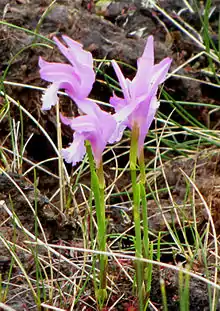Dragon's mouth
Arethusa bulbosa, commonly called dragon's mouth orchid,[4] is the only species in the orchid genus Arethusa.[3] The genus is named after a naiad of Greek mythology.[5] This monotypic genus is abbreviated Aret in trade journals.
| Dragon's mouth orchid | |
|---|---|
 | |
| Taken Pancake Bay, Ontario | |
| Scientific classification | |
| Kingdom: | Plantae |
| Clade: | Tracheophytes |
| Clade: | Angiosperms |
| Clade: | Monocots |
| Order: | Asparagales |
| Family: | Orchidaceae |
| Subfamily: | Epidendroideae |
| Tribe: | Arethuseae |
| Subtribe: | Arethusinae |
| Genus: | Arethusa L. |
| Species: | A. bulbosa |
| Binomial name | |
| Arethusa bulbosa | |
| Synonyms[3] | |
| |
This terrestrial and rare orchid occurs in Eastern North America from Manitoba east to Newfoundland and St. Pierre & Miquelon south to Virginia, with isolated populations in northern Saskatchewan and in the Carolinas.[3][6][7] It occurs in bogs, swamps and other wet lowlands. It grows to a height of 15 cm. It forms a large, single, pink terminal flower, with a showy lip and white and yellow fringed crests.[2]
Gallery
 Western Brook Pond Trail, Gros Morne National Park, Newfoundland and Labrador
Western Brook Pond Trail, Gros Morne National Park, Newfoundland and Labrador Drawing from Britton, N.L., and A. Brown. (1913). Illustrated flora of the northern states and Canada.
Drawing from Britton, N.L., and A. Brown. (1913). Illustrated flora of the northern states and Canada.
References
- Maiz-Tome, L. (2017). "Arethusa bulbosa". The IUCN Red List of Threatened Species. IUCN. 208. e.T64264102A67728533. doi:10.2305/IUCN.UK.2017-2.RLTS.T64264102A67728533.en.
- Justice, William S.; Bell, C. Ritchie; Lindsey, Anne H. (2005). Wild Flowers of North Carolina (2. printing. ed.). Chapel Hill, NC: Univ. of North Carolina Press. p. 52. ISBN 0807855979.
- Kew World Checklist of Selected Plant Families, Arethusa bulbosa
- Voitk, A & M. (2006). Orchids on the Rock: The Orchids of Newfoundland. Rocky Harbour, NL: Gros Morne Co-operating Association.
- University of Wisconsin, Orchids of Wisconsin, Arethusa bulbosa
- Flora of North America v 26 p 597, Arethusa bulbosa
- "Arethusa bulbosa". County-level distribution map from the North American Plant Atlas (NAPA). Biota of North America Program (BONAP). 2014.
External links
This article is issued from Wikipedia. The text is licensed under Creative Commons - Attribution - Sharealike. Additional terms may apply for the media files.
